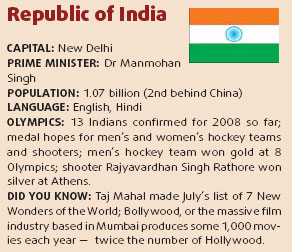Sander's students sing hooray for Bollywood
Bollywood big-wigs reeling from a recent fall in film profits can take some comfort from China, where the most colorful components of Indian culture are experiencing a new burst in popularity.

The famous song-and-dance movies of the subcontinent have a long history here, though in recent years have taken a backseat to Hollywood.
But don't mention the box-office blues to German-Indian dance sensation Sangeetha Sander, whose style reflects the visual feast for which Bollywood is best-loved.
Sander is finding a growing following for her new classes in Bollywood dance at Shanghai's Jazz du Funk studio.
Born in Berlin to Indian parents, Sander chose dance as a medium through which to connect with her heritage. She regularly performed in Germany with the three-member Triveni Dance Group, formed in 2003.
Her German husband's work brought them to China this year. Sander did not expect to find a strong Bollywood scene, but was thrilled at the opportunity to share her passion for dance through teaching at the studio.
"It is a change; it is really something different," says Sander, who arrived in China in June.

While still in Europe, Sander witnessed the booming popularity of Bollywood that followed the mainstream success of such movies as Monsoon Wedding. It was a fresh, colorful style without the restrictions of classical dance, but also a medium for cross-cultural understanding, she says.
"Bollywood was more fun and very light, but still we told stories, with our hand, face and body expressions all conveying meaning," says Sander, who trained in Indian classical Bharathanatyam from age 7, as well as ballet.
With love and the seasonal flux of emotions as central themes of the Bollywood genre, the dance is performed to popular songs from the films and may incorporate elements of modern, ballet, flamenco or hip-hop choreography.
Sander says Bollywood is an easy style for students who can relax and express the music through their movement.
"Some people feel maybe a little shy at the beginning of the class with all the hand gestures and facial expressions, with the smiling," she says.
The significance and vivid spectacle of a traditional Indian wedding can be difficult for foreigners to grasp at first.
"The dances always tell stories, and what I try to do in my classes is to tell them those stories. So, for example, there is one about a man who is going to get married," Sander says.
"I ask them to be dramatic and graceful - just imagine how an Indian wedding works, how the bride actually looks."
Sander experienced the legendary exuberance of the movie bride for herself in March last year. Dressed in a gold sari, her feet adorned with mehndi henna tattoos, Sander wed husband Mario in an elaborate, traditional ceremony in Bangalore, India.
The newlyweds honeymooned in the Maldives, later also hosting a large celebration in Germany to toast their union.
Sander completed her master's degree in English, social anthropology and Southasian studies, before leaving Berlin to reunite with husband Mario, who had come to Shanghai in March.
Sander grew up speaking German as well as her mother tongue of Tamil, a dialect of southern India. She learnt to read and write in Hindi as a young child and has always felt a strong bond with her Indian roots.
(China Daily 08/24/2007 page19)














